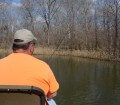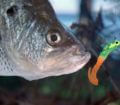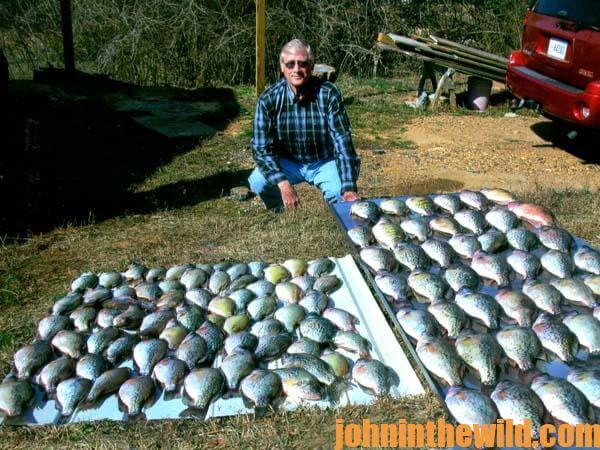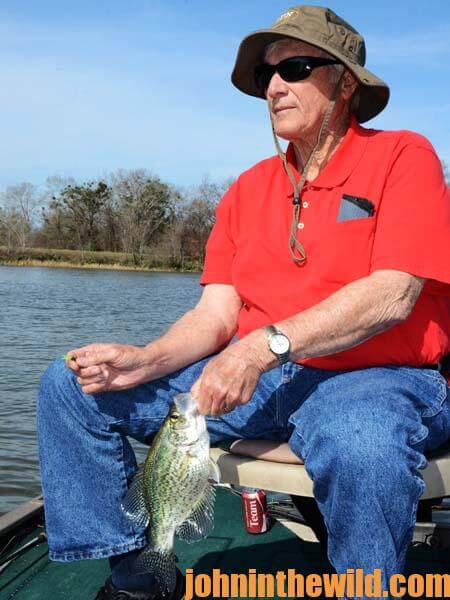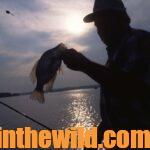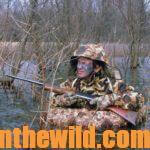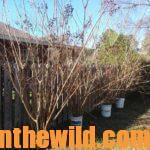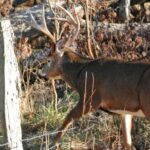John’s Note: Because David Spain usually fishes 3-4 days each time he goes crappie fishing, he lets the crappie tell him when the prespawn starts, and when the spawn ends.
If I had only one month to crappie fish, I’ll have to choose February. We catch the biggest and the most crappie in February, because they’re in that prespawn mode. As long as I’m catching plenty of big crappie and few small crappie, I’ll continue to fish. However, when I start catching 8 or 10 small crappie to every one big crappie, I believe the spawn is over, and it’s time to quit crappie fishing. Remember, I’m fishing the grass for the crappie that’s are in shallow water. Most people prefer to fish around wood cover like logs, stumps and treetops. However, I’ve had better luck fishing grass in shallow water. On the two river systems I fish, I believe that the crappie tend to prefer grass to spawn on rather than wood cover.
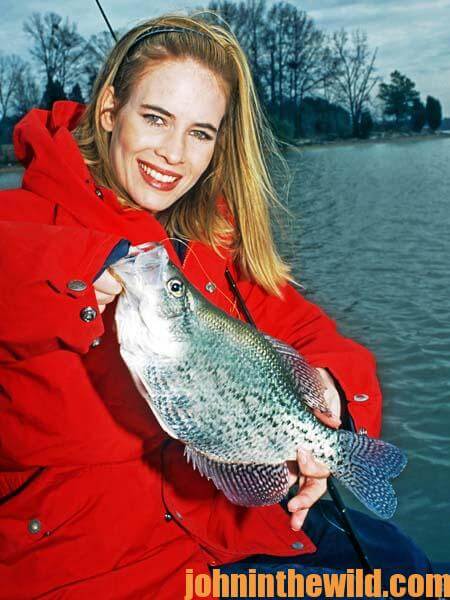 During the early season, before the grass starts appearing above the water, I’ve found that crappie will suspend over that underwater grass. Although we do cast to visible grass like cattails, this is the reason that we catch a good number of our better crappie about halfway between the visible grass and the boat. Besides, I like to cast and retrieve. I’ve tried pole fishing for crappie, and you can catch crappie like that here on the river, but I just prefer to cast and retrieve. I feel like I catch more crappie this way than when I’m drop fishing with a pole down the bank. Also, I believe that the people who are drop fishing down the bank have their boats positioned right on top of the suspended crappie that are waiting on the water to heat up before they go to the bank. So, those pole fishermen don’t have a chance to catch those suspended crappie that are farther out, away from the visible weeds. Also by casting and retrieving, we can cover more water quicker and put our jigs in front of more crappie than if we’re drop fishing down the bank.
During the early season, before the grass starts appearing above the water, I’ve found that crappie will suspend over that underwater grass. Although we do cast to visible grass like cattails, this is the reason that we catch a good number of our better crappie about halfway between the visible grass and the boat. Besides, I like to cast and retrieve. I’ve tried pole fishing for crappie, and you can catch crappie like that here on the river, but I just prefer to cast and retrieve. I feel like I catch more crappie this way than when I’m drop fishing with a pole down the bank. Also, I believe that the people who are drop fishing down the bank have their boats positioned right on top of the suspended crappie that are waiting on the water to heat up before they go to the bank. So, those pole fishermen don’t have a chance to catch those suspended crappie that are farther out, away from the visible weeds. Also by casting and retrieving, we can cover more water quicker and put our jigs in front of more crappie than if we’re drop fishing down the bank.
Although we primarily catch white crappie where we fish, the black crappie move in about March 15 each year. Generally, the black crappie will be bigger than the white crappie. When they move into shallow water, we’ll usually catch more black crappie than we do white crappie.
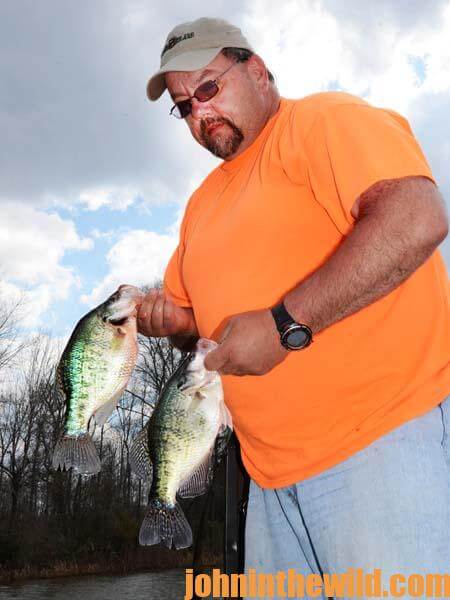 As I’ve mentioned earlier, my friends and I see the wind as our friend, and I prefer to cast into the wind when I’m casting and retrieving down the bank. I’ve found that controlling the boat when fishing into the wind is much easier than when we’re fishing with the wind at our backs. Usually, crappie don’t like really-fast moving baits. So, if you’re fishing with the wind to your back, the boat is moving downwind, and the wind is pushing your cork downwind. As you retrieve, you’re pulling the line downwind, which may cause the jig to move too fast for the crappie to want to take it. So, I’ve learned that I can control the boat, and we can control our casts much better when we fish into the wind than when we fish with the wind. Another advantage that fishing into the wind provides is that you often get a lot of slack in your line when you’re fishing with the wind at your back. When you’ve got that big bow in the line, you can’t set your hook as fast as you can when you’re retrieving slack, as the wind blows your cork and jig toward you.
As I’ve mentioned earlier, my friends and I see the wind as our friend, and I prefer to cast into the wind when I’m casting and retrieving down the bank. I’ve found that controlling the boat when fishing into the wind is much easier than when we’re fishing with the wind at our backs. Usually, crappie don’t like really-fast moving baits. So, if you’re fishing with the wind to your back, the boat is moving downwind, and the wind is pushing your cork downwind. As you retrieve, you’re pulling the line downwind, which may cause the jig to move too fast for the crappie to want to take it. So, I’ve learned that I can control the boat, and we can control our casts much better when we fish into the wind than when we fish with the wind. Another advantage that fishing into the wind provides is that you often get a lot of slack in your line when you’re fishing with the wind at your back. When you’ve got that big bow in the line, you can’t set your hook as fast as you can when you’re retrieving slack, as the wind blows your cork and jig toward you.
Just last year I started night fishing during the summer months on Guntersville Lake in north Alabama. Guntersville has the reputation of being one of the nation’s best big bass lakes. Although Guntersville is known for exceptional crappie fishing outside the city limits of Guntersville, the people who live around Guntersville Lake have learned that there are good-sized crappie to be caught up there too. I like to fish Guntersville at night using lights and fishing straight down with minnows and jigs. Primarily, we fish around bridges on the edges of creek channels. During the summer months, we’ll catch 30-40 crappie every night we fish, but we haven’t caught any really-big crappie up there. During the hot summer months, the fish will average about 10- or 11-inches long, but at least we can go crappie fishing when we normally can’t crappie fish on the Warrior or the Tombigbee rivers.
To learn much more about crappie fishing, get John E. Phillips’ Kindle eBooks and some print books, “Crappie: How to Catch Them Fall & Winter,” “Crappie: How to Catch Them Spring and Summer,” “Catch Cold Water Crappie Now” and “Catch Crappie All Year: Fishing a Single Pole, Using No Boat and Farming Crappie.” Click here to get these books.
To receive and download for free “The Crappie Catchers’ Cookbook,” by John and Denise Phillips that offers free recipes, go to https://johninthewild.com/free-books.

